Choosing between hand tied and tape in hair extensions isn’t just about looks-it’s about your lifestyle, hair health, and how much time you’re willing to spend on upkeep. Millions of women switch to extensions every year to add length, volume, or color, but not all methods are created equal. If you’re torn between hand tied and tape in, you’re not alone. The right choice depends on your hair type, budget, and how you live your life. Let’s cut through the marketing hype and show you exactly what each type does, how they feel, and which one lasts longer without damaging your natural hair.
What Are Hand Tied Hair Extensions?
Hand tied extensions, also called weft or bead extensions, are small strands of hair sewn onto a thin, flexible weft. Each weft is then attached to your natural hair using tiny beads and thread. The result? A seamless blend that moves naturally with your hair. These extensions are typically made from 100% human hair and come in 10- to 20-inch lengths. They’re lightweight and sit close to the scalp, making them ideal for fine or thin hair.
Installation takes about two to three hours and requires a trained stylist. The beads are threaded onto your natural hair, then the weft is stitched onto the thread. No glue, no heat, no clips. That means less damage over time. You can wash, style, and sleep with them just like your own hair. Most people get them redone every 6 to 8 weeks as their hair grows.
Hand tied extensions are popular among people who want a natural look for daily wear-think yoga classes, beach days, or long workdays. They don’t pull or tug like clip-ins, and they don’t leave visible tracks like some other methods. But they do require more maintenance. You can’t just throw your hair up in a bun without checking the beads. And if you sleep with wet hair, the beads can loosen.
What Are Tape In Hair Extensions?
Tape in extensions use double-sided adhesive strips to bond thin wefts of hair directly to your natural strands. Each weft is about 1 to 2 inches wide and 1.5 inches long. The extension is sandwiched between two sections of your natural hair, creating a strong hold without beads or sewing. Installation takes less than an hour, and many salons offer same-day service.
Tape ins are great for people who want quick results with minimal salon visits. They’re thicker than hand tied wefts, so they add more volume fast. That makes them a top pick for those with medium to thick hair who want dramatic changes. The adhesive is medical-grade and designed to hold for 6 to 8 weeks. When it’s time to remove them, a special solvent dissolves the tape without pulling out your natural hair.
But there’s a catch. Tape ins can slip if you use the wrong products. Sulfate shampoos, silicone-based conditioners, and heavy oils break down the adhesive. You’ll need to avoid these, or your extensions will start sliding out midday. Also, if they’re not installed correctly-too close to the scalp or too tight-they can cause tension headaches or even hair breakage. And while they’re easy to install, they’re harder to hide. If your hair is fine or light-colored, the tape can sometimes show as a thin line near the roots.
Which Lasts Longer?
Both hand tied and tape in extensions last about the same amount of time: 6 to 8 weeks. But how they hold up during that time is very different.
Hand tied extensions stay secure as long as the beads stay tight. With proper care, they rarely slip. But if you’re someone who sweats a lot, works out daily, or swims often, the thread can weaken over time. You’ll need to visit your stylist every 4 to 6 weeks just to tighten the beads.
Tape in extensions rely on adhesive strength. If you follow the product rules-no sulfates, no oil near the roots-they’ll stay put. But if you forget one wash, they can start sliding. Many users report losing 10 to 20% of their tape ins before the 6-week mark. That means more frequent touch-ups, which adds to the cost.
Bottom line: Hand tied wins for consistency. Tape in wins for speed. But neither lasts a full three months without some kind of maintenance.
Which Is Better for Your Hair?
This is where most people get it wrong. The best extension isn’t the one that looks the prettiest-it’s the one that doesn’t wreck your natural hair.
Hand tied extensions are gentler on fine or fragile hair. Because they’re distributed evenly across multiple small beads, there’s less pressure on any one strand. That reduces the risk of traction alopecia-a real problem with heavy extensions. They’re also removable without chemicals, which means less chemical stress on your scalp.
Tape ins are fine for thicker hair, but they can be rough on fine or damaged hair. The adhesive pulls on the hair shaft when removed, and if the tape is applied too close to the scalp, it can cause irritation or even small bald spots. Studies from the Journal of Clinical and Aesthetic Dermatology show that improper tape in use increases the risk of hair breakage by 40% in users with fine hair textures.
If your hair is already thinning, chemically treated, or prone to breakage, hand tied is the safer bet. If your hair is healthy and thick, tape in can work-but only if you’re disciplined about product choices and salon visits.
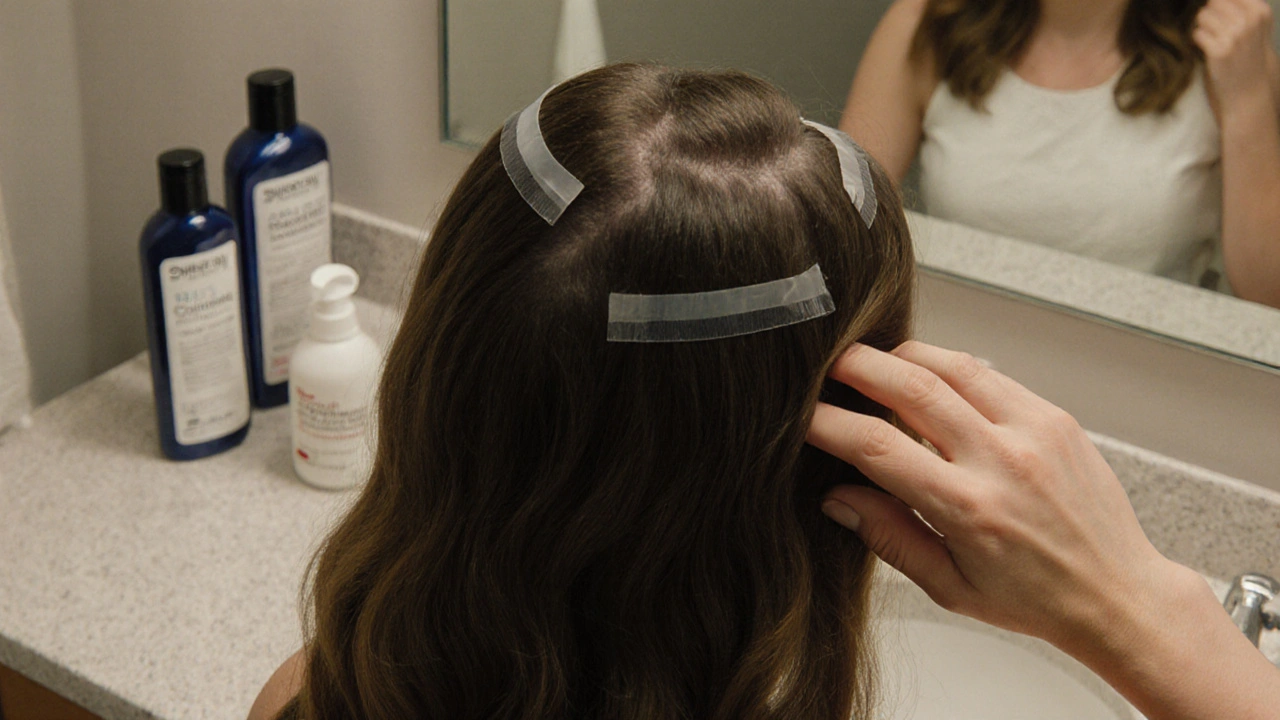
Which Feels More Natural?
When you run your fingers through your hair, you should feel like it’s all yours. Hand tied extensions win here. The wefts are thin, flexible, and sit flush against the scalp. They move with your hair in every direction-no stiffness, no bulk, no weird lumps.
Tape ins are bulkier. The adhesive strips add thickness, and even the best ones can feel slightly rigid, especially when you’re wearing your hair down. Some users say they can feel the tape when they brush their hair forward. If you’re someone who likes to wear your hair in a high ponytail or bun, tape ins can sometimes lift slightly, revealing the edges.
For a truly invisible look-especially if you have lighter hair or want to wear your hair pulled back-hand tied is the clear winner.
How Much Do They Cost?
Hand tied extensions usually cost between $600 and $1,200 for a full set, depending on hair length and quality. Installation runs $200 to $400 extra. Maintenance every 6 to 8 weeks adds another $100 to $150.
Tape in extensions cost $300 to $800 for the hair itself, with installation at $150 to $300. But because they need more frequent touch-ups (every 4 to 6 weeks), the total cost over a year can be higher. If you lose 10% of your tapes every 6 weeks, you’ll need to buy replacement wefts more often.
Hand tied has a higher upfront cost, but it lasts longer between visits and doesn’t require replacement wefts as often. Tape in is cheaper to start, but the recurring costs add up.
Who Should Choose Hand Tied?
- You have fine, thin, or fragile hair
- You want a natural, undetectable look
- You’re willing to spend time on maintenance
- You swim, sweat, or work out regularly
- You prefer no glue or chemicals near your scalp

Who Should Choose Tape In?
- You have medium to thick hair
- You want quick results with minimal salon time
- You’re okay with following strict product rules
- You want more volume than length
- You don’t mind checking for slippage after washing
What Happens If You Get It Wrong?
Bad installation can ruin your hair. If tape ins are applied too close to the scalp, they can cause scalp inflammation. If hand tied beads are too tight, they can pull on your roots and cause pain or hair loss. Both methods can lead to breakage if you tug on them while brushing or styling.
Always go to a certified extension specialist. Look for salons that specialize in extensions-not just hair salons that offer them as an add-on. Ask to see before-and-after photos of clients with your exact hair type. If they can’t show you real examples, walk away.
And never try to install either type yourself. Even if you find a YouTube tutorial, the risk of damage is too high. One wrong move with tape adhesive can strip your hair. One too-tight bead can cause permanent thinning.
Final Verdict: Which Is Best?
If you want the most natural, longest-lasting, and hair-friendly option-go with hand tied. They’re the gold standard for people who care about their hair health and want extensions that disappear into their own hair.
If you need volume fast, have thicker hair, and don’t mind a little more upkeep, tape in works. But only if you’re strict about product choices and salon visits.
There’s no one-size-fits-all answer. But if you’re still unsure, ask your stylist to do a hair health check first. Your hair’s condition-not your Instagram feed-should decide what’s best for you.
Can I swim with hand tied hair extensions?
Yes, you can swim with hand tied extensions, but you need to take precautions. Rinse your hair with fresh water before swimming to reduce chlorine or salt absorption. Wear a swim cap if possible. After swimming, wash your hair with a sulfate-free shampoo and gently dry the beads to prevent loosening. Avoid letting them soak in water for long periods.
Can I dye tape in extensions?
It’s not recommended. The adhesive on tape in extensions can break down when exposed to chemical dyes or bleach. Even if you only dye the ends, the chemicals can seep into the tape and cause it to lose its grip. If you want color changes, it’s safer to choose extensions that are already the shade you want.
How often should I wash my hair with extensions?
Wash your hair every 3 to 4 days, no more than every other day. Overwashing weakens the bonds-whether beads or tape. Use sulfate-free, gentle shampoos and avoid scrubbing near the attachment points. Always condition from mid-length to ends, never the roots.
Do hand tied extensions cause headaches?
They shouldn’t-if installed correctly. Hand tied extensions are lightweight and spread out, so they rarely cause pressure. But if the beads are too tight or too many are placed in one area, you may feel discomfort or tension headaches. Always ask your stylist to check the tension before you leave the salon.
Can I use heat tools on both types of extensions?
Yes, both hand tied and tape in extensions are usually made from 100% human hair, so you can use flat irons, curling wands, and blow dryers. But always use a heat protectant spray. Avoid direct heat on the tape or beads-this can melt the adhesive or weaken the thread. Keep heat tools at least 1 inch away from the attachment points.

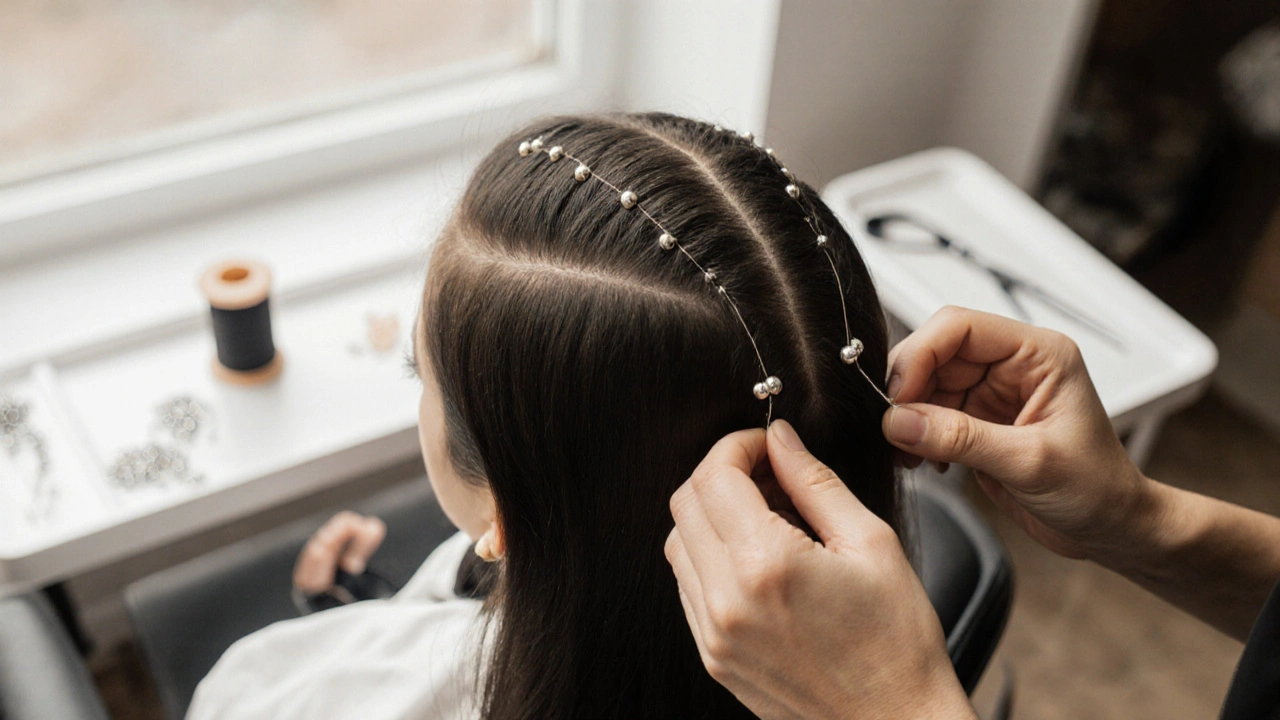
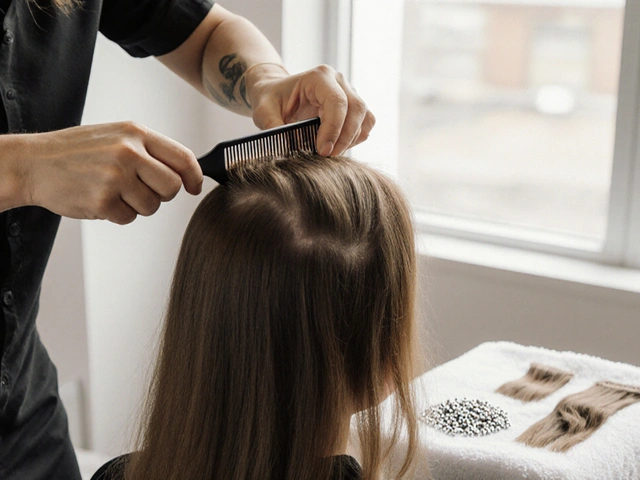
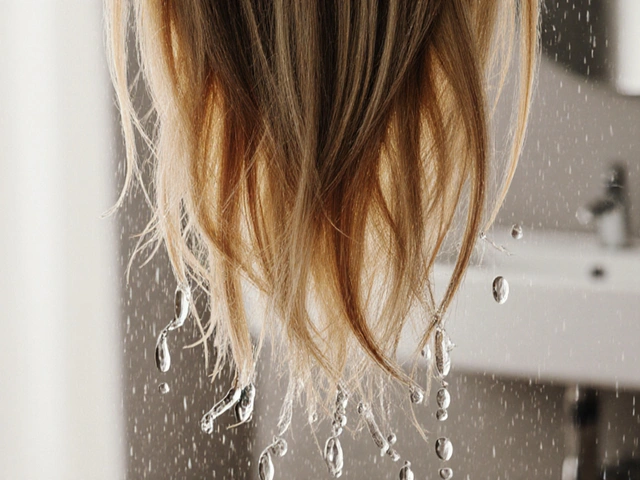
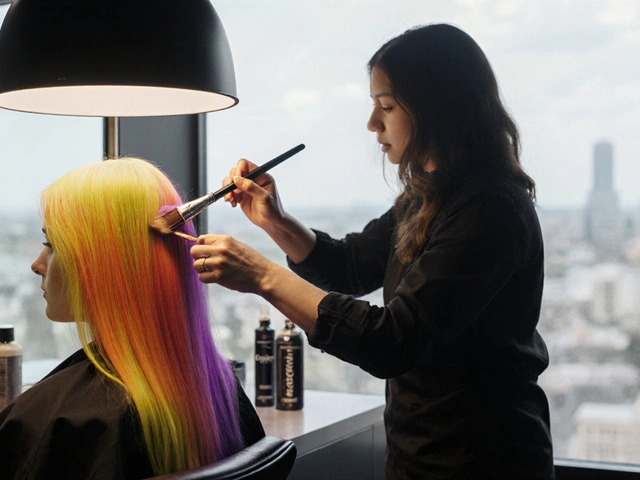


Raji viji
November 11, 2025 AT 06:40Hand tied? Please. That’s just a fancy way of saying ‘I have too much time and not enough brain cells.’ Tape-ins are for people who want results without playing Jenga with their scalp. I’ve worn both - hand tied felt like wearing a wig held together with dental floss. Tape-ins? Sleek, fast, and if you use the right shampoo, they don’t vanish after two washes.
Rajashree Iyer
November 11, 2025 AT 23:27Oh my god. I just cried reading this. I’ve been wearing tape-ins for two years and I swear, every time I brush my hair, I feel like I’m betraying my ancestors. The adhesive? It’s not glue - it’s emotional trauma wrapped in silicone. Hand tied? That’s the quiet meditation of hair extension life. You sit there, beads like tiny prayers, each one a silent vow to your hair’s dignity. I’m not just wearing extensions - I’m healing.
Parth Haz
November 12, 2025 AT 18:53While both methods have their merits, I would argue that the decision should be guided primarily by dermatological evidence and long-term follicular health. The study referenced in the Journal of Clinical and Aesthetic Dermatology is compelling - particularly the 40% increase in breakage with tape-ins among fine-haired individuals. Additionally, the cumulative cost analysis over a 12-month period favors hand-tied extensions when maintenance frequency and replacement rates are factored in. A data-driven approach yields the most sustainable outcome.
Rohit Sen
November 13, 2025 AT 05:51Elmer Burgos
November 14, 2025 AT 14:58I tried both and honestly? I think it depends on your vibe. Hand tied felt like my hair finally had a hug. Tape ins? Felt like my scalp was being held hostage by a sticky note. But I’m not here to judge - just sharing what worked for me. Also, never use sulfate shampoo. Ever. I learned that the hard way.
Antwan Holder
November 15, 2025 AT 05:28Do you even feel your hair anymore? Or are you just numb from the trauma of trying to be ‘beautiful’ in a world that tells you your natural self isn’t enough? Tape-ins are capitalism’s answer to insecurity. Hand tied? That’s the quiet rebellion of someone who still believes in patience. I used to wear tape-ins until I looked in the mirror and didn’t recognize the hollow eyes staring back. Now I wear my hair bare - and I’m finally free.
Angelina Jefary
November 15, 2025 AT 17:10Wait - the article says ‘medical-grade adhesive’? That’s a lie. There’s no such thing as ‘medical-grade’ for hair tape. That’s just marketing jargon. The FDA doesn’t regulate hair extension adhesives. And who wrote this? A salon owner? The ‘studies’ cited? Probably paid for by a hand-tied brand. This whole thing is a scam. Also - ‘sulfate-free’? That’s a scam too. Sulfates clean hair. Period. Stop being manipulated.
Jennifer Kaiser
November 17, 2025 AT 09:15I’ve had both. I had hand tied extensions for six months after my chemo. They didn’t just add length - they gave me back my sense of self. The beads? They felt like little anchors holding me together. Tape-ins? I tried them once. Felt like my scalp was being glued shut. I cried the whole time. I don’t care about cost or convenience - I care about how it makes you feel when you look in the mirror. If you’re choosing based on Instagram, you’re already losing.
TIARA SUKMA UTAMA
November 18, 2025 AT 05:25Jasmine Oey
November 18, 2025 AT 13:46Hand tied? Honey, that’s for people who think ‘bun’ is a verb. I have thick hair, I want volume, and I don’t have time to babysit beads. Tape ins? I put them in on a Tuesday, went to brunch on Thursday, and my hair looked like a Kardashian threw up on it - in the best way. Also, I’m not paying $1200 to look ‘natural.’ I’m paying to look like I’ve been on a yacht for three weeks straight. And I don’t apologize.
Marissa Martin
November 18, 2025 AT 15:58I just wish people would stop treating hair like it’s a project that needs fixing. You’re already beautiful. Extensions are just… another way to say you’re not enough. I know I’m not popular for saying this. But I had to say it.
James Winter
November 20, 2025 AT 13:09Aimee Quenneville
November 20, 2025 AT 23:46So… hand tied = yoga mom energy, tape in = ‘I just got out of a Netflix rom-com and now I’m ready to conquer the world’? Honestly? I’m team tape-in. I wear mine while I’m screaming at my cat and eating cold pizza at 2am. The beads? They’d fall out during my dramatic sighs. Tape-ins? They hold on like my ex’s last text - annoying, but stubbornly there.
Cynthia Lamont
November 22, 2025 AT 20:32Let me just say - if you’re using conditioner near your roots with tape-ins, you’re doing it wrong. And if your stylist says ‘it’s fine’ when the tape is visibly lifting? Run. I’ve seen people with bald patches from this. And no, ‘sulfate-free’ doesn’t mean ‘I can use my aunt’s coconut oil shampoo.’ That stuff is glue poison. Also, hand tied isn’t ‘gentler’ - it’s just slower damage. The beads pull on your follicles over time. It’s not magic. It’s physics. And if you think your hair is ‘healthy’ because you’re not using heat - you’re delusional. Your hair is a battlefield. Choose your weapon.
Raji viji
November 23, 2025 AT 21:05Oh wow, Cynthia, you just broke the fourth wall. I’ve been using coconut oil on my tape-ins for months and now I have a bald spot shaped like a question mark. You’re right - it’s not magic. It’s just me being lazy and pretending I’m a hair goddess. Also, I just Googled ‘treatment for traction alopecia’ and now I’m crying in my yoga pants. Thanks for that.